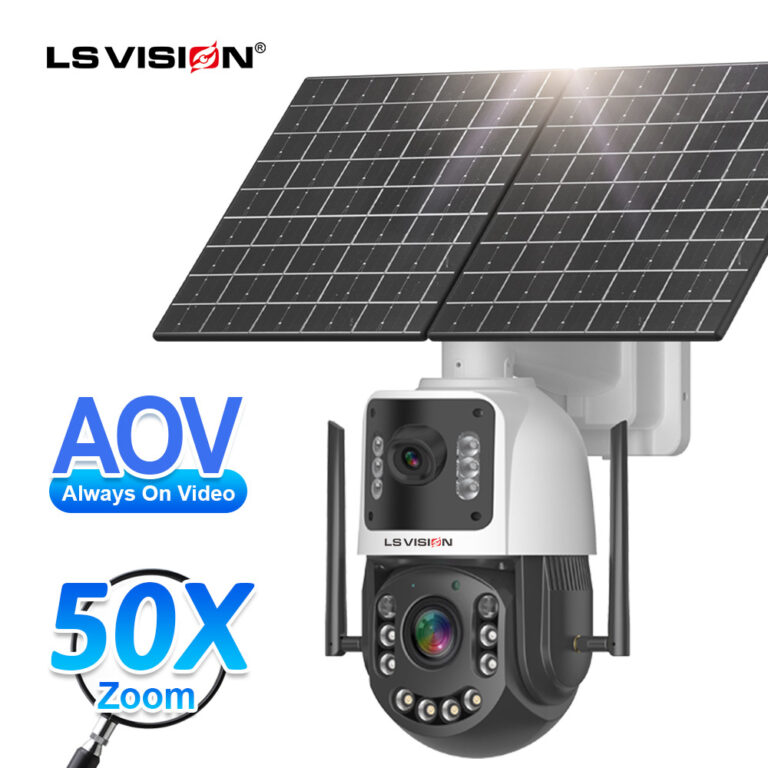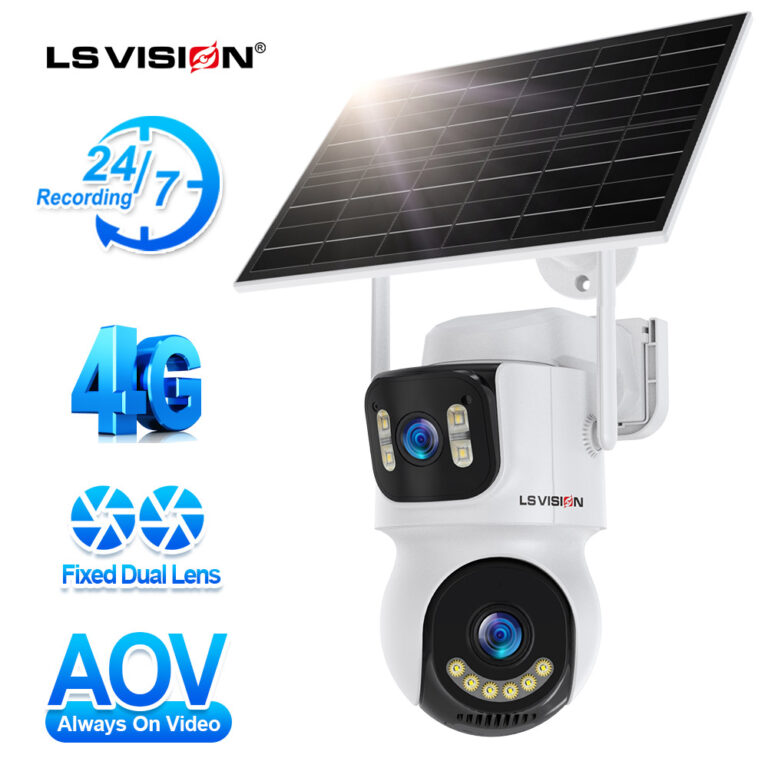Deploying over 50 solar security camera systems on a large site might seem difficult, but with the right approach, it can be a manageable and efficient solution. Whether you’re securing a construction site, industrial park, or any large-scale facility, having a robust surveillance system is crucial for safety and security. In this article, we will guide you through the essential steps for deploying a wireless solar security camera system, offering tips on planning, installation, and maintenance.
Step 1: Assess the Site Requirements
The first step, before anything else, is to determine the specific requirements of the site before getting into the technical deployment details. This includes
目次
トグルSite Size and Layout: The layout of the site and its size should be understood. Where and how you place the cameras will depend on the dimensions and configuration of the area.
Power Needs: Since you are choosing solar security camera systems, make sure that site has adequate sunlight exposure or choose a required less exposure system with energy storage.
Network and Connectivity: Check the available network infrastructure. If there’s Wi-Fi or mobile coverage on site, you can use a wireless camera. If the site is remote, cellular cameras might be necessary.
Security Objectives: Determine the most critical locations to observe, such as boundaries, access points, or high-value areas like storage or equipment zones.
Step 2: Choose the Right Solar Security Cameras
The next important decision is choosing the wireless solar security camera system. For a large site, construction site solar camera should meet certain criteria:
High Resolution: Cameras should be high definition enough to identify any incident clearly.
Wide Coverage: Select cameras with wide-angle lenses or PTZ features to cover expansive areas effectively.
Night Vision: Choose models that allow you to see clearly in low light and night.
Weather Resistance: The cameras must be strong enough to withstand outdoor weather conditions and not get damaged easily.
For large-scale deployments, models like the LS-WL660-50X are ideal. They offer 50× optical zoom and 360° PTZ control, making them suitable for monitoring expansive sites such as construction zones or industrial parks.

Step 3: Plan Camera Placement
Once you’ve chosen the appropriate cameras, the next step is to plan where to place them. Camera placement is crucial for ensuring comprehensive coverage of the site. Here are a few tips:
High-Traffic Areas: Place cameras near entry and exit points to monitor all personnel and vehicle movements.
Perimeter: Ensure cameras cover the entire boundary of the site, detecting unauthorized access from all directions.
High-Value Areas: Focus extra cameras on areas with valuable assets, equipment, or materials.
It’s important to place cameras at strategic heights and angles to reduce blind spots and ensure maximum coverage.
Step 4: Set Up Solar Power Systems
To power your solar security cameras effectively, it is essential for you to deploy them in a way that optimizes their performance:
Solar Panels: Choose panels that are appropriately sized for your camera’s energy consumption. Panels should be installed where they can receive maximum sunlight during the day.
Batteries: Install high-quality batteries to store power for the cameras, especially for nighttime operation. Ensure that the batteries have enough capacity to last through cloudy days or periods of limited sunlight.
Mounting: Securely mount the panels and batteries in locations where they won’t be easily tampered with, but still get sufficient sunlight.
Step 5: Establish Connectivity
To work effectively, a wireless solar security camera system needs reliable connectivity. Depending on the site’s infrastructure:
Wi-Fi: Wi-Fi connectivity allows cameras to be connected to the local network if the site is supported with a strong Wi-Fi network.
4G/5G LTE: Cellular-enabled cameras can use internet services in remote locations where Wi-Fi isn’t possible.
Hybrid System: You may use both Wi-Fi and cellular networks at the same time.
Make sure you connect the cameras to a central monitoring system to keep an eye on them remotely.
Step 6: Configure Monitoring and Alerts
A wireless solar security camera system is most effective when it’s connected to a centralized monitoring platform. Key features to set up include:
Live Streaming: View all cameras at once so you can respond to things as they happen.
Motion Detection: Turn on motion sensors to the cameras so they alert you to anything suspicious.
Cloud Storage: Use cloud-based storage to store your footage for security and easy access to your past footage when needed.
Mobile Access: Make Sure the System Allows Access Via Phones or Tablets to observe the site’ condition from almost anywhere.
Using systems like Milesight’s SiteGuard Suite or other NVR platforms will help centralize your surveillance for easy access and control.
Step 7: Perform Regular Maintenance
To ensure the optimum performance of your solar system security camera, routine maintenance is a must. Here’s what to check:
Clean Solar Panels: The efficiency of solar panels can be hampered by dust and dirt residue. Make sure to clean them often for enough sunlight.
Inspect Camera Lenses: You should check camera lenses which are important to maintain quality footage for your recording.
Battery Health: Make sure you get your battery checked often and replace them whenever necessary to avoid power disruption.
Software Updates: The camera’s firmware and software need to be updated to prevent any security vulnerabilities and improve functionality.
Best LS VISION Cameras for Large-Scale Projects
When deploying in large numbers, the selection of the right cameras becomes very important. You need cameras that can cover large areas with reliable performance in difficult conditions. Here are some of the best solar security camera systems for larger projects along with their features:
1. LS-WL660-50X
With its high performance, advanced features and robust construction, the LS-WL660-50X is the preferred choice for large scale projects. Here’s why it’s ideal for expansive sites:
50× Optical Zoom: The camera has a 50× optical zoom, enabling it to pick up stunning detail from afar. It’s especially valuable for wide area monitoring like roads, industrial parks or airports. You can zoom in to focus on certain objects or persons from a distance.
360° PTZ Control: The LS-WL660-50X pan-tilt-zoom 360° can be used with full coverage of large open spaces. With this feature, users can remotely alter the camera’s focus to a specific area in real time to ensure that no section is left unmonitored. Use of physical security barriers help to reduce security threats from potential crime and criminals.
ONVIF and NVR Integration: The LS-WL660-50X is ONVIF compliant and can work with NVRs of different brands with the necessary setup and configuration. With integration into network video recorders, you can monitor multiple cameras through one interface, enabling control of your chosen camera system. The operation will be more manageable and efficient.
Durability: The materials used to make the LS-WL660-50X are quite durable. Hence, it will not get damaged easily. Regardless of whether exposed to extreme temperatures, dust, rain or direct sunlight, this camera is designed to perform reliably in tough conditions, making this camera ideal for remote locations or large-scale infrastructure.
2. LS-CS102-50X (AOV Series)
The LS-CS102-50X from AOV series is an advanced option for projects that need continuous monitoring. It’s equipped with many features that make it a valuable asset for large deployments:
Always-On Video: This camera supports continuous recording with no gaps. Always-on video for uninterrupted events that matter. This is especially useful for locations that need constant supervision, such as construction sites, warehouses, or high-security areas. With the always-on video option, you will not lose out on any critical footage.
50× Optical Zoom: LS-CS102-50X comes with a 50× optical zoom just like the LS-WL660-50X. With a better resolution than other types of cameras, a Megapixel IP camera captures minute details from a distance. Even the smaller details can be seen clearly. Thus it is great for watching over large areas that need to be monitored. It is suitable for perimeters or entry points that need a higher level of scrutiny.
Energy Efficiency: The LS-CS102-50X is designed to be energy efficient, combining performance with lower energy consumption. It is a good option for semi-project, semi-retail customers who require decent security and not too much power. This makes it the perfect solution for remote sites where there is little or no access to any power for operation on solar power.
Weather-Resistant Design: The LS-CS102-50X is built to withstand the harsh conditions, making it a great option when installing outdoors. It is built to work in any climate including cold winters and hot sunny summer and work all the time..
3. LS-CS3 または LS-4GS22 (Entry-Level Models)
For a cheaper but effective solution for your project, LS-CS3 or LS-4GS22 are good entry-level options. These models give great performance with excellent reliability:
Cost-Effective: The LS-CS3 and LS-4GS22 are cheaper options that allow you to cover larger spaces. While they may lack some advanced features of high-end models, they still offer reliable security, making them a great choice for less critical zones or supplementary monitoring in large deployments.
Reliable Coverage: These low-cost cameras are designed to offer trustworthy coverage of your property at an economical price. A proper camera installation will help you monitor important spaces with better cost-performance ratio. These cameras are ideal for monitoring access points, parking lots or other areas on site that do not call for high-end camera capabilities.
Easy to Deploy: The LS-CS3 and LS-4GS22 feature easy to install design for quick troubleshooting. Their simple setup process and flexible installation options are perfect for quickly deploying large areas. These cameras can be easily fixed onto present poles or structures. Their plug-and-play design further simplifies installation.
Good for Supplementary Monitoring: These entry-level models are great for less sensitive parts on large sites. Ideal for use in tandem with advanced surveillance systems, ensuring that every corner of your site is monitored without requiring advanced high-end cameras in every zone.
Why Choose LS VISION?
LS VISION is a trusted supplier of solar security camera systems with high pleasure solutions for all industries. LS VISION has durable, effective, and affordable surveillance products for construction sites, industrial parks, etc. Each of our cameras has been designed with innovation so that it can blend easily in any situation and secure urban and remote locations.
Whether it’s high-end cameras for sizable projects or inexpensive cameras for extra coverage, LS VISION has a diverse product line to meet your needs.
結論
Using 50+ mobile solar security cameras on a large site helps with monitoring and security. It also helps to deter crime and prosecute offenders. By planning out the deployment, selecting the right equipment, ensuring consistent power and connectivity, and maintaining, you are ensuring that your site is fully secured while the security cameras work well.
If you want a construction site solar camera system, then the LS-WL660-50X model does 50× optical zoom, PTZ control, etc. It can also integrate with an NVR platform. This model is very reliable and useful for large-scale projects.
For more information on how to deploy a solar security camera system at your site or to get a tailored solution, contact LS VISION today at +86 13544211486 or email us at sales@lsvisionsolar.com. Our team of experts is here to help you design and implement the perfect surveillance solution for your needs.













